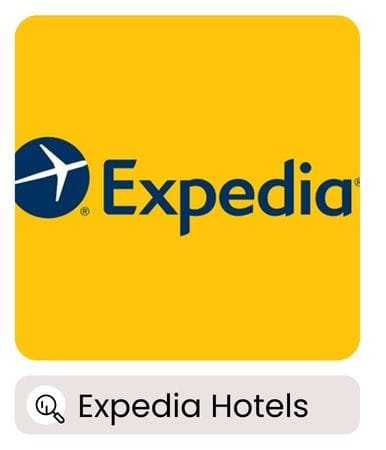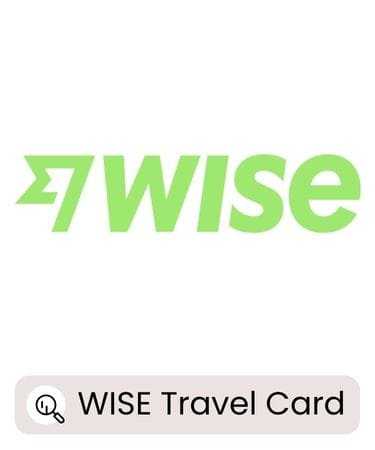29 Nights | 12 Locations | Marrakech, Ait Ben Haddou, Dades Gorge, Todgha Gorge, Sahara Desert, Meknes, Chefchaouen, Fes, Rabat
From vibrant medinas and ancient kasbahs to golden sand dune deserts and green mountain valleys, Morocco is a destination that truly has it all. After spending a month driving through the country, here’s a breakdown of our exact itinerary and key tips to help you plan your own unforgettable Self-Guided explore of Morocco.

What to Know Before You Go
Visas & Entry Requirements
Before you pack your bags and head off to explore the souks, mountains, and desert magic of Morocco, make sure your travel documents are sorted.
Most nationalities (including Australians, New Zealanders, Europeans, Brits, Canadians and Americans) can visit Morocco visa-free for up to 90 days. That gives you plenty of time to wander the medinas, ride camels into the Sahara, and sip mint tea to your heart’s content.
Just double-check that your passport is valid for at least six months from your arrival date — Moroccan border control will want to see that before letting you in. Always check official government travel sites before your trip, as visa rules can change. It’s a quick step that can save a massive headache later.
Getting Around
We chose to rent a car in Morocco — and honestly, it was one of the best decisions we made. Having our own wheels gave us the freedom to explore the mountains, desert towns, remote kasbahs, and scenic routes at our own pace.
The roads are generally in good condition, especially around larger cities like Marrakech, Fes, and Rabat. Once you head into more rural or mountainous regions, things get a little more interesting — think tight switchbacks, the occasional pothole, and a lot of sharing the road with goats, donkeys, slow-moving scooters and people loaded in the backs of trucks.
You’ll need to be a confident and alert driver. Moroccan traffic can be a little… creative, and city driving (especially near medinas) isn’t for the faint-hearted. Expect unexpected turns, random stops, and the occasional moment of pure chaos.
Police checkpoints are common, especially when crossing between provinces or near major intersections. Make sure to have all your rental paperwork, license, and passport handy. Most checks are routine and friendly — but, full transparency: we did experience a roadside “fine” for a questionable ‘reason’. It’s rare, but not unheard of. Our tip? Stay calm, polite, and follow the road rules to a T.
If self-driving isn’t your thing, Morocco also has a decent network of trains, buses, and private drivers — but for us, the freedom of a rental car made all the difference. I think it would be a lot of organising and trust to organise individual transfers and trips between locations.
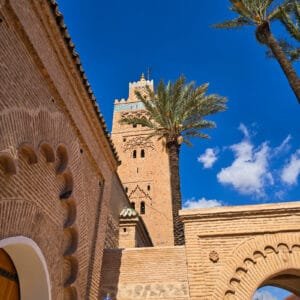
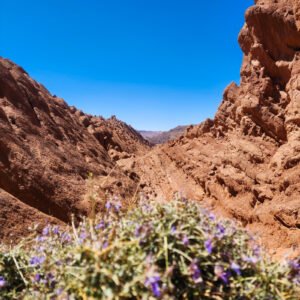
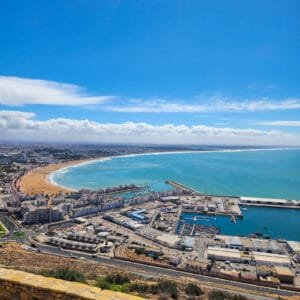
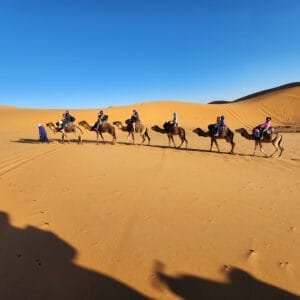
Budget Tips
Morocco is known for being budget-friendly, especially once you step outside the busiest tourist hubs. Whether you’re wandering smaller towns or rural villages, you’ll find your money goes a long way.
One of the best ways to experience authentic Moroccan hospitality without breaking the bank is by staying in riads — traditional guesthouses often set within beautiful old buildings. Riads offer excellent value, with charming rooms, friendly hosts, and a genuine taste of local life.
When it comes to food, Morocco is a paradise for budget travellers. Traditional Moroccan dishes like tagine, couscous, and street snacks are delicious and very affordable. Similarly, markets are full of bargains on clothing, shoes, and crafts — perfect for picking up unique souvenirs without overspending.
Another plus: fuel prices are generally cheaper than in Europe, so if you’re driving, that’s one less cost to worry about.
With a little planning and an open mind, Morocco can be an incredible trip that doesn’t blow your budget.
Best Time to Visit
The best times to visit Morocco are spring (March to May) and autumn (September to November). During these months, you’ll enjoy pleasant temperatures, comfortable days, and fewer crowds — ideal for exploring cities, hiking in the mountains, or wandering desert landscapes without overheating.
Summer (June to August) can be scorching, especially in the Sahara and inland areas, with temperatures often soaring above 40°C (104°F). If you’re travelling during this time, plan your activities for early mornings or evenings to avoid the heat.
Winter (December to February) brings cooler weather, especially in northern and mountainous regions. Coastal cities like Casablanca and Essaouira remain mild, but the Atlas Mountains can see snow and freezing temperatures — perfect if you want to combine your trip with some winter hiking or even skiing.
Choosing the right season can make all the difference in how you experience Morocco’s diverse landscapes. We visited for the month of March, beginning of April. We found the weather variable, some days hot, some days cold, others freezing and others perfect.
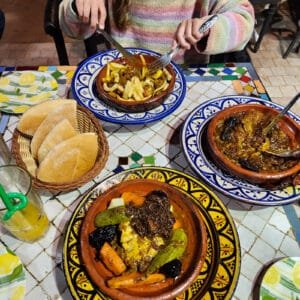
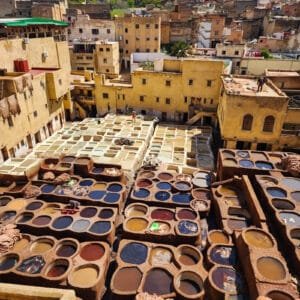
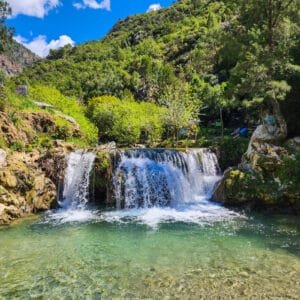
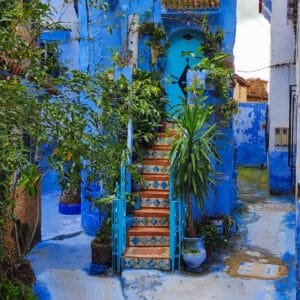
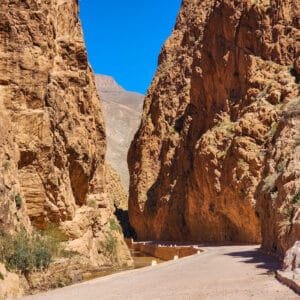
Money in Morocco
When it comes to handling money in Morocco, cash is king — it’s used for almost everything, from street food to market shopping and small services. While some larger hotels and restaurants accept cards, most daily transactions rely on Moroccan dirhams (MAD) in cash.
If you’re planning to use a card, make sure it can withdraw cash at ATMs, as these are widely available in cities and towns. One of the best tips we found was to use fee-free cards and withdraw money from Maroc Post office ATMs, which often charge no withdrawal fees — a real saver when you’re managing a travel budget.
To keep our cash safe, we carried most of it in a money belt worn under our clothes, with just enough for daily expenses kept in Dan’s pocket. This strategy helped us avoid flashing large amounts of cash when paying and reduced the risk of pickpocketing.
It’s wise to carry a mix of cash and card, and always notify your bank of travel plans to avoid any issues.
Packing Tips for Morocco
Packing smart for Morocco means preparing for diverse climates and respecting local customs. Here are some essentials we recommend:
- Lightweight layers are a must. Days can be hot, especially in the desert, but nights can get surprisingly cold—sometimes dropping to near freezing. Think breathable fabrics you can easily add or shed.
- Culturally appropriate clothing is important. Morocco is a predominantly Muslim country, so dressing modestly helps you blend in and shows respect. For women, this usually means covering shoulders and knees, and avoiding tight or revealing clothes.
- Closed walking shoes are essential for wandering the uneven, often cobbled streets of medinas. Comfortable sneakers or sturdy sandals with good grip work best.
- A scarf or shawl serves multiple purposes: protecting your face and neck from sun and sand, covering your head when visiting mosques, or just adding a bit of style.
- Don’t forget sunscreen and sunglasses — the Moroccan sun can be intense, especially in open desert areas.
- If you plan to visit rural or mountain areas, pack a light rain jacket — spring and autumn can bring unexpected showers.
- Leave the Drone at home! It is illegal to bring a drone into Morocco with you without prior approvals. It is much easier to just leave it at home.
Packing with versatility and respect will help you feel comfortable, confident, and ready for anything Morocco throws your way.
Our 4-Week Morocco Itinerary
Marrakech (3 Nights) – Marrakech: Morocco’s Most Iconic City
Marrakech is a vibrant blend of ancient culture, buzzing souks, and sensory overload. Known as the “Red City” thanks to its terracotta buildings, it’s a must-visit for anyone exploring Morocco. We didn’t have a car here and didn’t need one — the city is best explored on foot or by local taxi. Plus, cheap flights in and out of Marrakech make it a popular starting and/or finishing point for Moroccan adventures. Here’s how to make the most of 3 days in Marrakech.
Things to See & Do:
- Koutoubia Mosque & Parc Lalla Hasna – a peaceful green space next to the iconic 12th-century mosque.
- Cyber Park – a shady park filled with cats, fountains and local life.
- Jemaa el-Fnaa – the chaotic but must-see main square packed with snake charmers, performers, food stalls, and thousands of people.
- Ben Youssef Madrasa – a beautifully restored 14th-century Islamic school with intricate tilework, wooden carvings and peaceful courtyards. Entry: 100 MAD.
- The Medina & Souks – get lost in the maze-like streets filled with textiles, spices, lamps, and leather goods – just keep your wits about you. Be prepared for pushy vendors, pickpockets, and scams involving fake guides. We found the wider streets easier to enjoy.
- Other places we didn’t get to but are recommended are: Jardin Majorelle, a wander around Gueliz, Le Jardin Secret, horse and carriage ride.
Where to Eat:
- Restaurant Anzar – for traditional dishes like tagine, couscous, and skewers at reasonable prices.
- Snack Toubkal – a fantastic budget option right in the square, offering tasty food, sunshine and balcony views. Great value (AU$28 for 3 meals, rice, and juices).
Accommodation:
- We stayed at Riad Sofia, a traditional Moroccan apartment just outside the medina. It had a central lounge, private rooms across multiple floors, and a rooftop terrace where we watched giant storks and the neighbourhood unfold below. It gave us a great mix of local immersion and space to relax.
Travel Tips:
- Stay alert in the medina, especially around opening/closing hours when scams and pickpockets are more active.
- Don’t drink the tap water – even salads can be risky due to how they’re washed.
- Expect hustle and sensory overload – that’s part of the Marrakech experience.
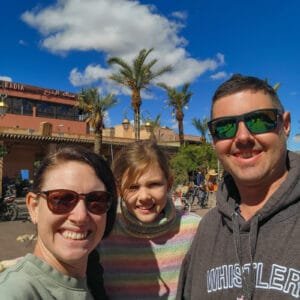
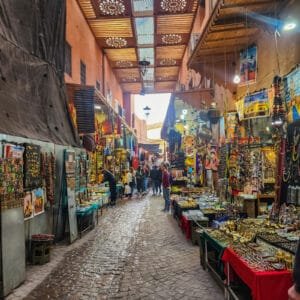

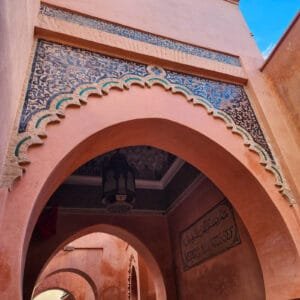
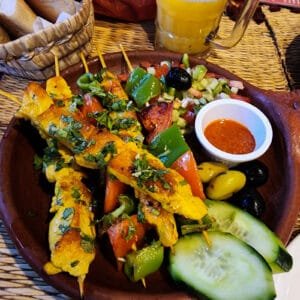
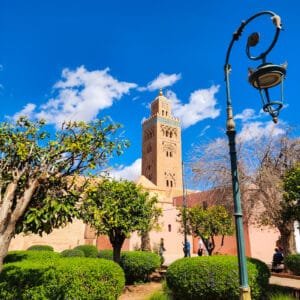
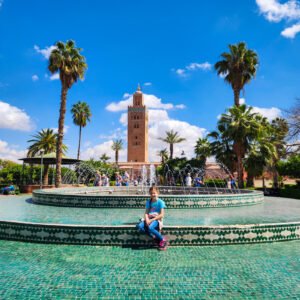
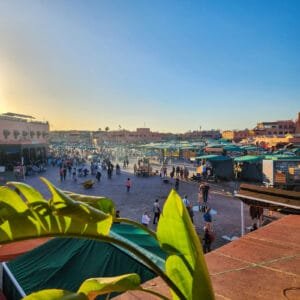
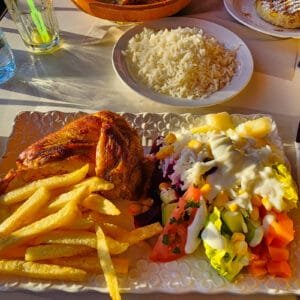
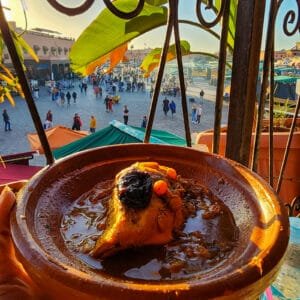
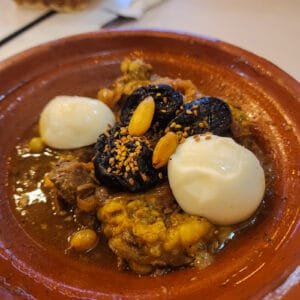

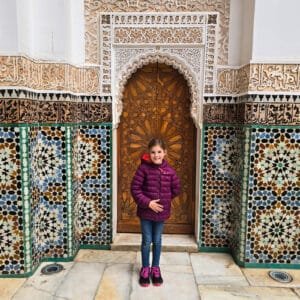
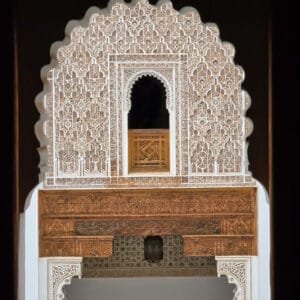
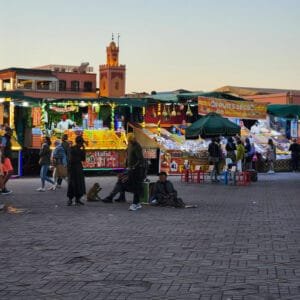
Accommodation
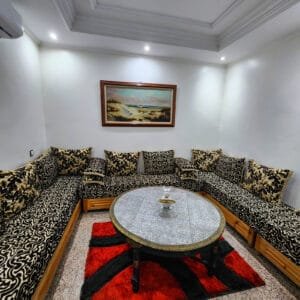
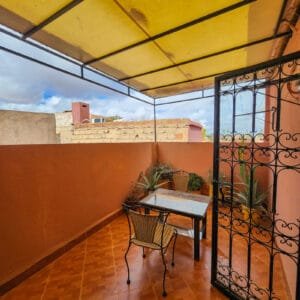
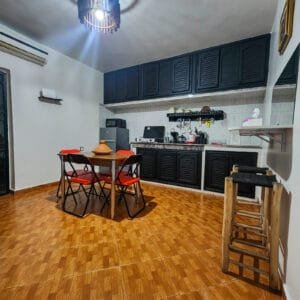
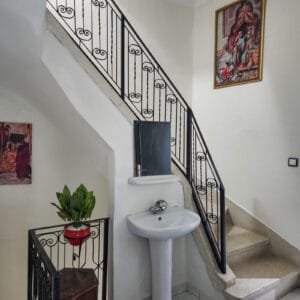

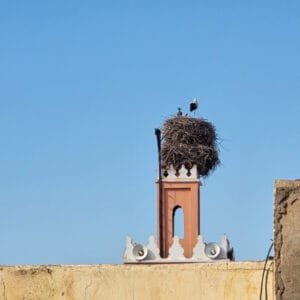
Anza, Agadir Area – (3 Nights) – Where the desert meets the sea
After picking up our rental car at Marrakech Airport (we caught a taxi from Marrakech), we officially kicked off our Moroccan Road Trip. The drive to Anza took us southwest through a changing landscape—arid desert, rugged mountains, and finally the Atlantic coast. Be prepared: while the roads near major cities are in good condition, this stretch had us questioning whether we had enough spare tyres!
Things to Do in Anza & Surrounds:
- Anza Dinosaur Footprints A must-see while in the area, these fossilised dinosaur tracks are located right on the shoreline. Dating back 85–100 million years, they were left during the Cretaceous period and are best viewed at low tide, when the rock shelves are exposed. A small fossil museum nearby (entry fee applies) gives further insight into Morocco’s prehistoric past.
- The tracks are just a 5-minute walk from central Anza.
- Follow the painted dino footprints on the road to the viewing area.
- The clearest tracks are right behind the info board at the southern end of the beach.
- Wear grippy shoes as the rocks can be slippery.
- Free to visit, and usually uncrowded — a real hidden gem.
- Argan oil production – If you’re visiting between December and March, you might even spot Argan oil production in action. Women from local cooperatives often set up outside their homes or shops, cracking argan nuts and pressing oil by hand. It’s a great chance to see the process up close — and buy directly from the source.
- Visit the Agadir Fortress – Kasbah Agadir Oufella – Just a short drive from Anza is Kasbah Agadir Oufella, the historical fortress that overlooks the modern city of Agadir. Originally built in 1540 by the Saadian dynasty, the kasbah was mostly destroyed in the 1960 earthquake, but the outer walls and panoramic views remain a compelling reason to visit. Drive access is restricted — only taxis, tour buses or shuttles can reach the top. We parked in the public carpark 500m below and walked up. You can enjoy the outer viewpoint area for free, which includes several English-language information boards. Tickets are needed to enter the reconstructed interior (approx. $35AUD including one audio guide bought at the Kasbah), but after doing both, we found the paid experience didn’t add significantly more than the free signage and views.
- Agadir City – Just a short drive south, Agadir is a modern coastal city offering long beaches, shopping malls, and wide palm-lined boulevards. While much of the original city was destroyed in a 1960 earthquake, it’s a good place to stroll the beachfront promenade, visit the Agadir Marina for cafes and restaurants, explore the Souk El Had, a sprawling market with everything from spices to electronics, try Moroccan mint tea or a classic tagine in one of the many local eateries — we particularly enjoyed the chicken and vegetable and beef and prune varieties.
Accommodation:
- We based ourselves in Anza, a small beachside suburb just north of Agadir. Our Airbnb was a newly built apartment with touches of Moroccan design and lovely ocean views. Anza caters more to surfers and backpackers, so family-friendly options were a little more limited compared to other areas.
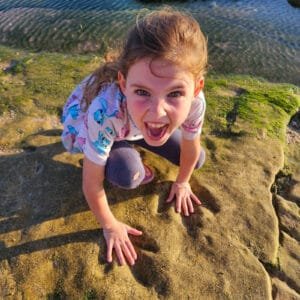

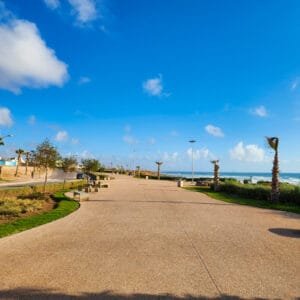
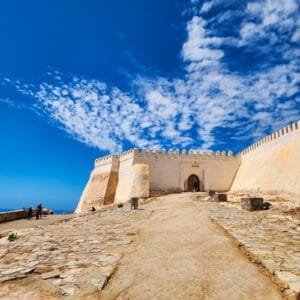

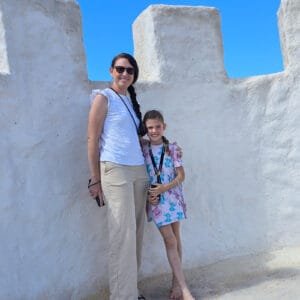

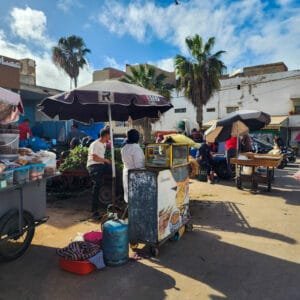
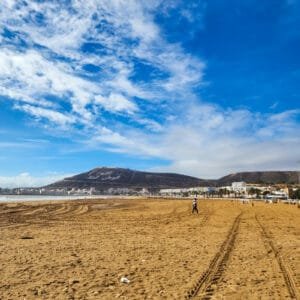
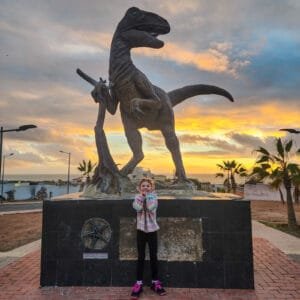
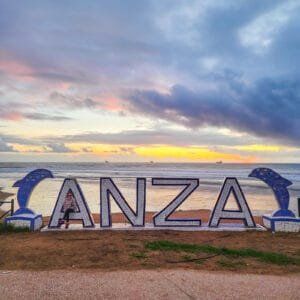
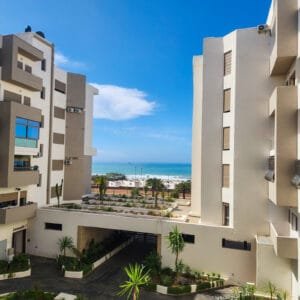
Taliouine (1 Night) – Morocco’s Saffron Capital
Taliouine is a quiet town nestled between the Atlas Mountains and the desert, best known for its saffron production. For most travellers, it’s a convenient stopover point when travelling between Agadir or Taroudant and destinations like Aït Benhaddou or the Dadès Gorge — the drive would be too long to do in one stretch.
Things to Do
- Taliouine is not a tourist hotspot, which makes it an excellent place to experience genuine rural Moroccan life. A stroll through the town centre reveals welcoming locals and an atmosphere untouched by mass tourism.
- The town is famous for its saffron production, and if you’re visiting in October or November, the annual Saffron Festival showcases the harvest with music, markets, and cultural events. Nearby landscapes offer views of the Atlas Mountains and desert fringes, perfect for quiet contemplation or photography.
Where to Eat
- Eating options are limited but authentic. Many riads serve traditional tagines infused with locally grown saffron, a must-try specialty. Along the main road, you’ll find small cafés and bakeries offering fresh bread, pastries, and simple snacks. For those passing through, relying on your accommodation’s dinner or a local café is usually the best choice and that’s what we did.
Accommodation
- Taliouine offers a small selection of traditional riads and guesthouses, many family-run and modest but comfortable. We stayed at Auberge Restaurant Le Safran in a classic Riad-style accommodation with plenty of mosaic tilework and lovely views of the surrounding hills. Options here are limited compared to bigger cities, so it’s best to book in advance. Many riads also offer dinner on site, making for a convenient and authentic stay.
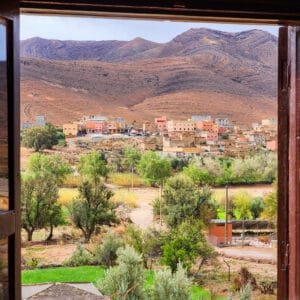
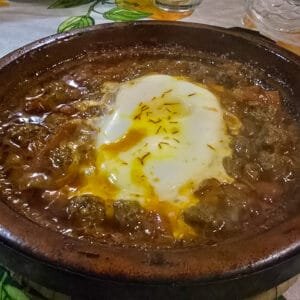
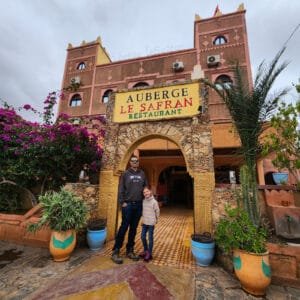
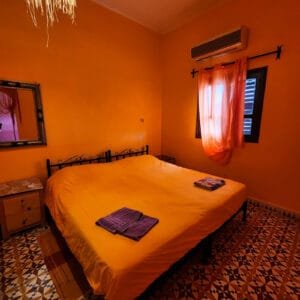

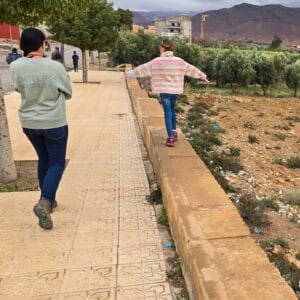
Ait Benhaddou (2 Nights) – Step Into Morocco’s Most Iconic Ksar
Aït Benhaddou is a UNESCO World Heritage Site and one of Morocco’s most famous fortified villages (a ksar), perched along the ancient caravan route between the Sahara Desert and Marrakech. Dating back to the 11th century, this stunning mudbrick village once protected and housed traders carrying salt, gold, spices, and slaves. It’s also a star on screen, having appeared in Game of Thrones, Gladiator, and The Mummy, making it a must-see for history buffs and film fans alike.
Things to Do:
- The main attraction is, of course, exploring the ksar itself. Wander the maze-like alleys where some streets are lined with souvenir shops, while others feel untouched by tourism. A tip for visiting: cross the river via the sandbag path, not the main bridge. This route offers a beautiful viewpoint and helps avoid the “tour guides” who may try to charge for entry — the ksar is free to explore. Along your walk, you might encounter local artisans, such as those creating traditional saffron and tea paintings, where natural pigments are applied and revealed with heat — a unique souvenir to consider. Don’t miss the stunning sunset views over the ksar, which truly highlight the village’s earthen architecture and cinematic atmosphere. There is an additional lookout viewpoint to the South of the town, so don’t forget to stop in there too for mountain views behind Ait Ben Haddou.
- A day trip drive to the nearby Atlas Mountains offer spectacular scenic drives. The famous N9 Highway passes through desert villages, dramatic gorges reminiscent of the Grand Canyon, and snow-capped peaks in winter — perfect for photography and nature lovers.
Accommodation:
- The nearby town and surrounding hills offer a range of accommodation, with several family-run riads providing authentic Moroccan hospitality. We stayed at Maison Salwa, a riad nestled just 10 minutes from the ksar, featuring comfortable rooms with private bathrooms, heating (which is useful during colder months), and views overlooking the canyon below. Prices are reasonable, with shared quad rooms available for around $48 AUD per night. Many riads have communal areas and terraces perfect for relaxing after a day of exploring.
Where to Eat:
- Dining options around Aït Benhaddou are limited but authentic. Many riads serve traditional Moroccan tagines and couscous, often using locally sourced ingredients and spices like saffron. In the nearby main town, casual snack spots offer simple, tasty, and affordable meals — expect mint tea to accompany nearly every dish as part of the local ritual. We enjoyed meals at our Riad, Snack restaurant Riyad Ait Ben Haddou and Snack Les Amis.
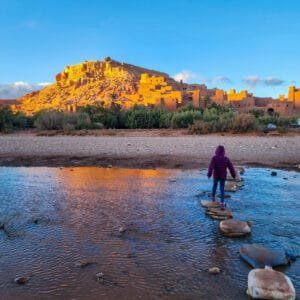
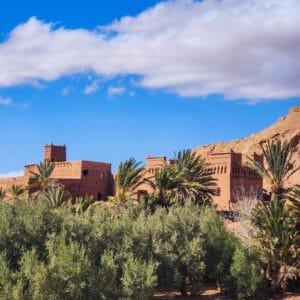
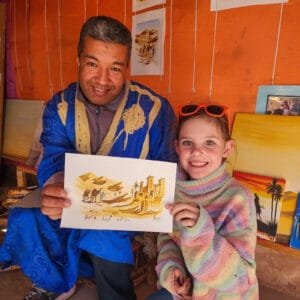
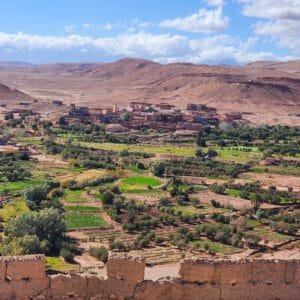
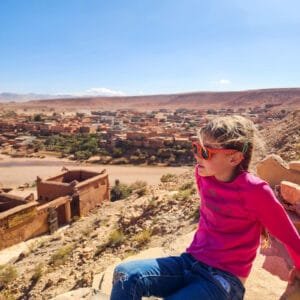
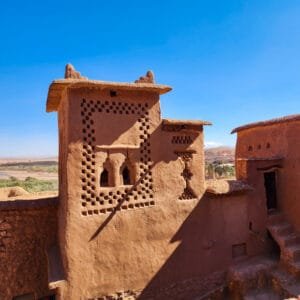
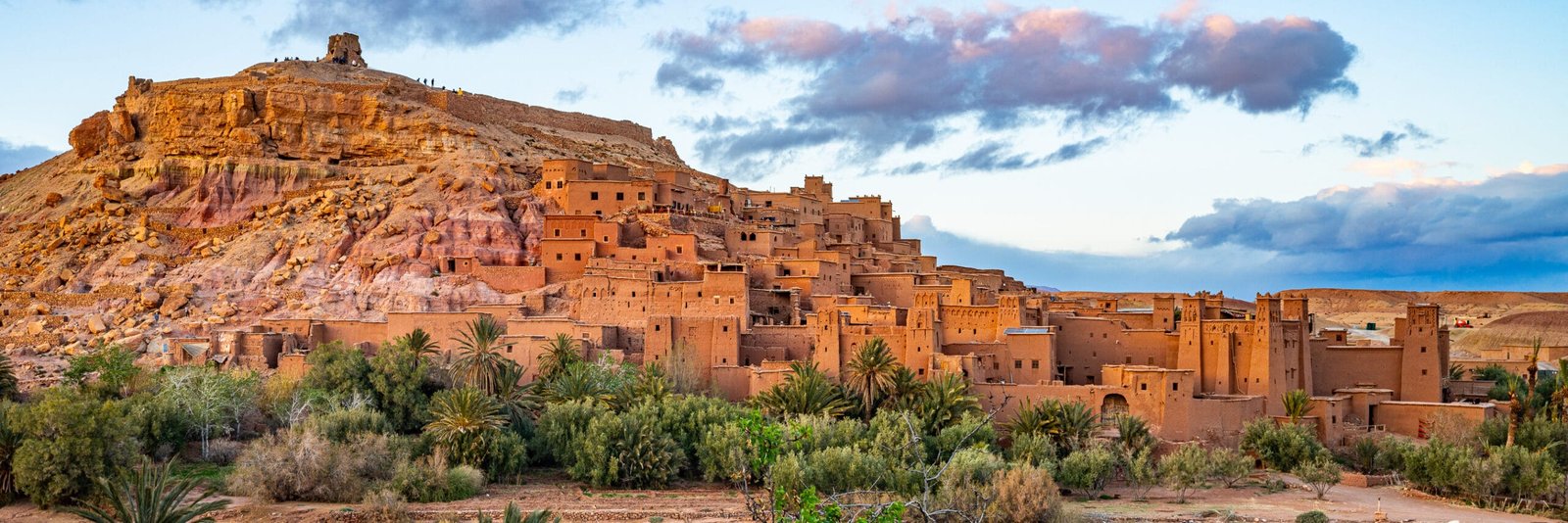
Accommodation and Eating Out

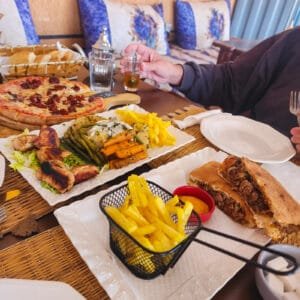
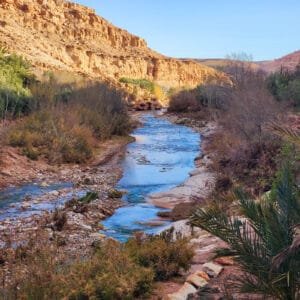
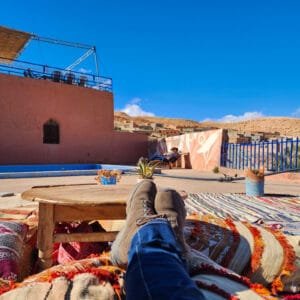
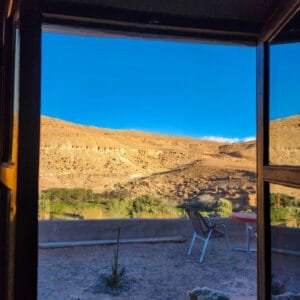
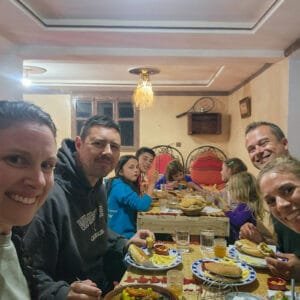

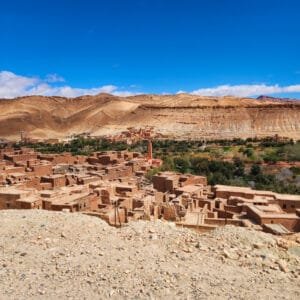
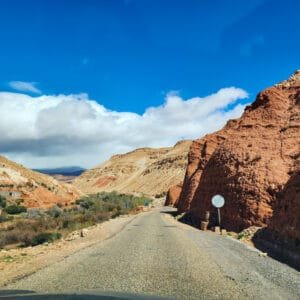
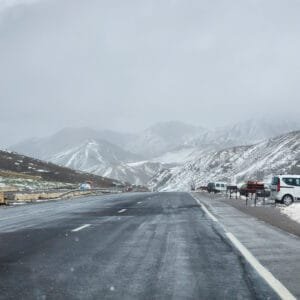
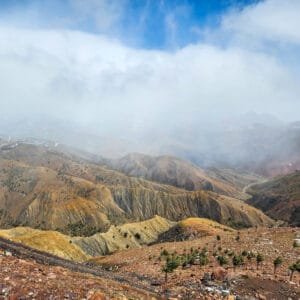
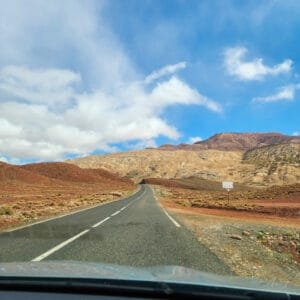
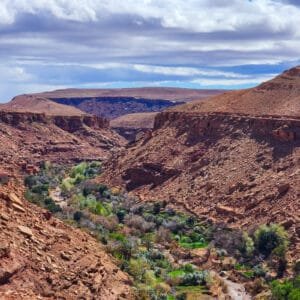
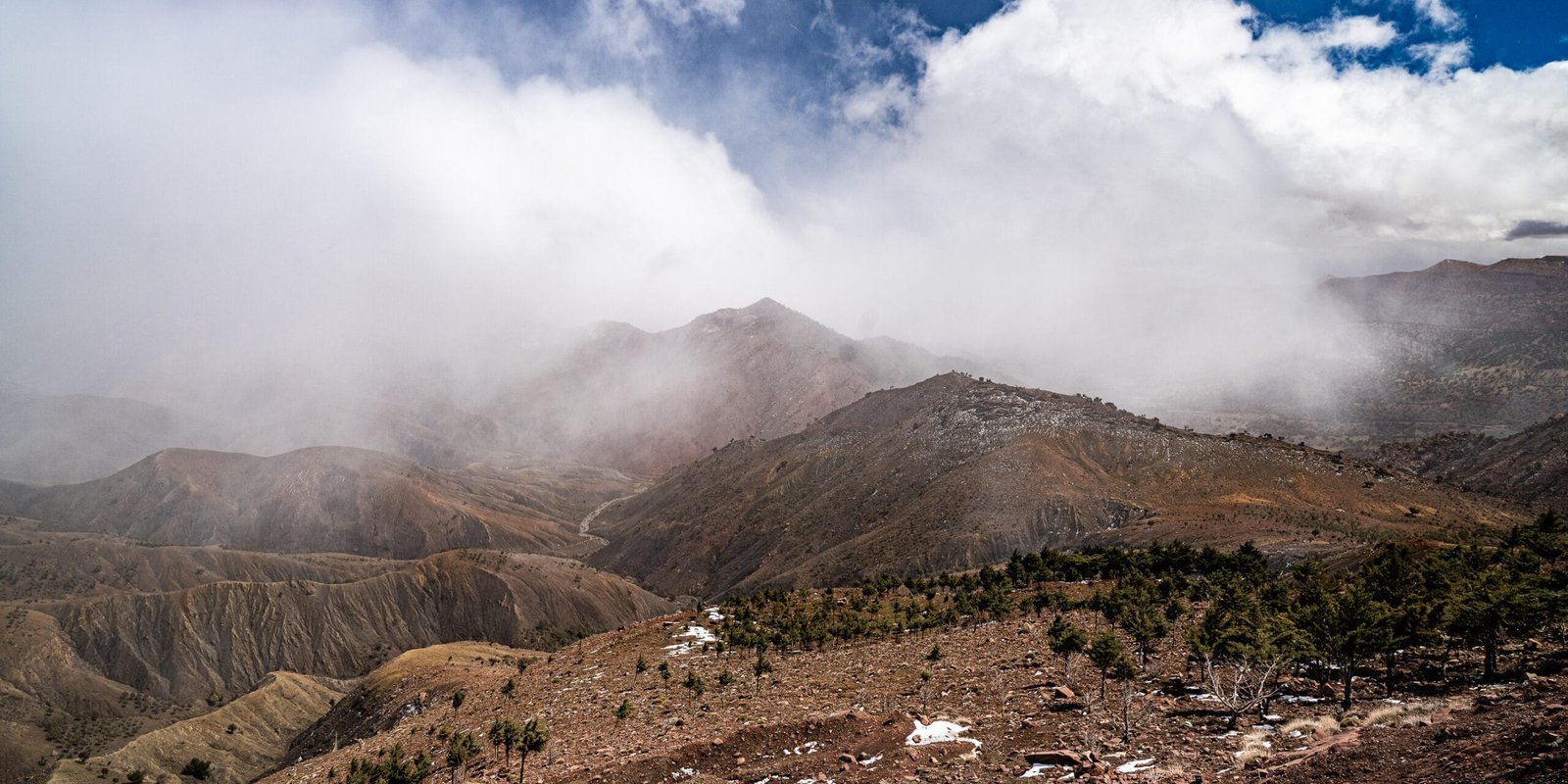
Dades Gorge (2 Nights) – Raw Landscapes, Rugged Trails & Traditional Hospitality
Dades Gorge, carved by the Dades River between the Atlas and Anti-Atlas Mountains, is known for its dramatic red rock formations, winding roads, and welcoming Berber villages. It’s a destination that blends adventure with tradition — and one of the most memorable stops on our Morocco journey.
Things to Do:
- The standout activity here is the Monkey Fingers Hike, a 13km loop through a surreal landscape of sculpted rock formations. The trail is completely unmarked — there are no signs or trailheads — so a local guide is essential. We were guided by the son of our friends’ riad host, and without him we would have been completely lost. The route involves boulder scrambling, crawling under overhangs, squeezing through tight rock corridors, and following dried riverbeds. It’s an adventurous, physical day — and absolutely worth it for the views and the sense of wildness.
- On the drive to Dades, stop at Kasbah Amridil in Skoura — one of the best-preserved kasbahs in Morocco, dating back to the 17th century. Entry is 40 MAD for adults, and children are free. Inside you’ll find traditional olive presses, historic rooms, and rooftop views that hint at the kasbah’s former significance.
- A surprising highlight was driving through a small mountain village where every door was painted green — homes, shops, garages — in every shade imaginable. It’s worth driving slow to photograph this charming local mystery.
Accommodation:
- We stayed at Hotel Atlas Gorge Dades a traditional riad-style guesthouse with views across the valley. As with many places in the region, we were greeted with mint tea on arrival and ate dinner on-site. Our room was simple but atmospheric, and breakfast was served the next morning on a sunny rooftop terrace — a peaceful way to start the day.
- Many riads here are family-run and can help arrange hikes or transport. In our case they helped organise a guide for the Monkey Fingers Hike.
Where to Eat:
- Dining options are limited in the Dades Gorge, so it’s best to eat where you’re staying or at the few restaurants on the main road. Most riads offer a half-board option, with dinner and breakfast included or available for a small extra cost. We ate our meals at our accommodation and they were all great.
- Meals typically feature classic Moroccan dishes such as vegetable tajines, chicken with preserved lemon, or slow-cooked beef with prunes — all served with fresh bread and mint tea. Breakfasts are simple but filling: local breads, jams, olives, eggs, and tea or coffee, usually served on a terrace or in a cosy dining room.
If you are confident to navigate the hike on your own, I suggest downloading the All Trails App and download the map. This will give you a much better chance of following the trail as there are no trail markings along the route.
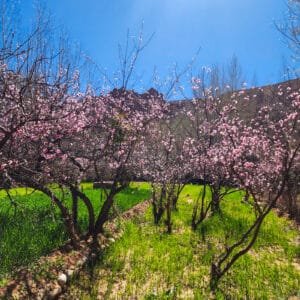

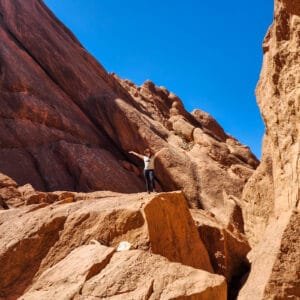
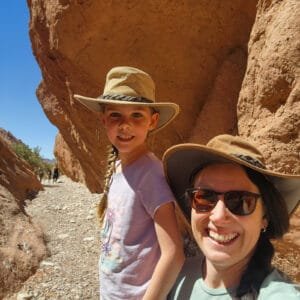

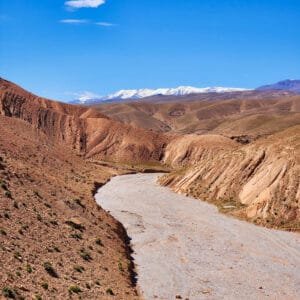
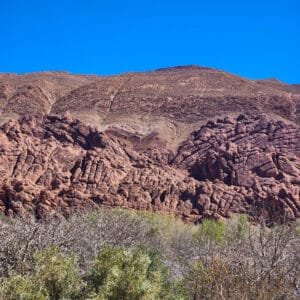
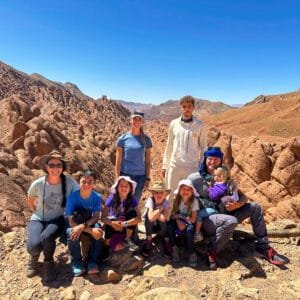
Accommodation & Kasbah
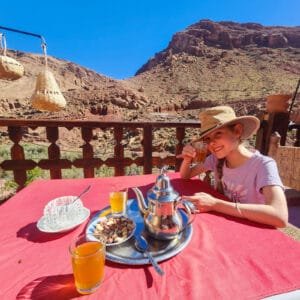
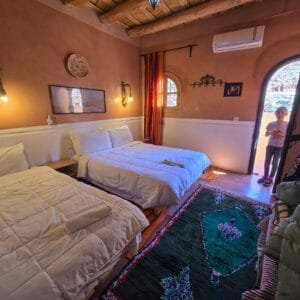
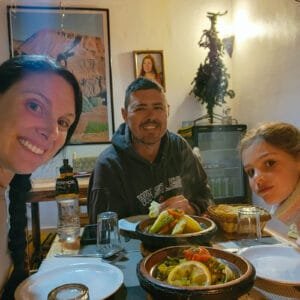
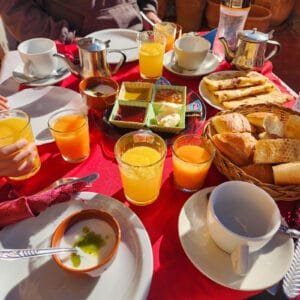
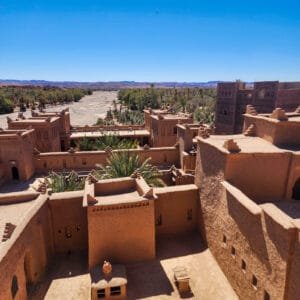
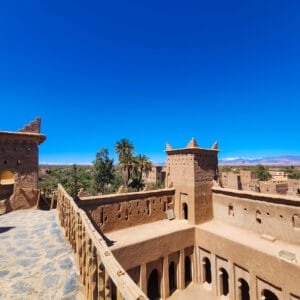
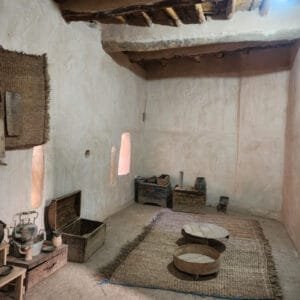
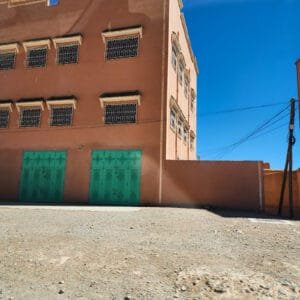
Tinghir / Todgha Gorge (2 Nights) – Towering Canyons, Hidden Trails & Offbeat Adventures
A practical base for exploring the Todgha Gorge, Tinghir is a mid-sized town nestled between the Dades and Todgha river valleys. While the town itself isn’t particularly scenic or atmospheric compared to other Moroccan villages, it’s conveniently located for accessing one of the most spectacular natural sights in the region.
Things to Do:
- Hike Todgha Gorge: The main reason to stop in Tinghir is to explore the towering canyon walls of Todgha Gorge, carved by a crystal-clear river that runs through the base. A popular hike begins near the main carpark and follows the river upstream. Early on, you’ll find a shaded coffee van — a perfect stop for juice or espresso before setting out. The route winds past lush gardens, stone walls, and local farmland before climbing to scenic viewpoints. The full loop is around 12km, but shorter versions are equally rewarding.
- Visit an Abandoned Kasbah (Unintentionally!): One of our wanderings took us through a maze of dry paths and farmland — leading straight into an old, abandoned kasbah. Though not a formal attraction, stumbling upon ruins like this is part of what makes Morocco special. A kind local pointed us back to the main trail — reminding us how helpful people are even when you’re far from typical tourist routes.
- Scenic Drive via Route N12: If you’re arriving from the Dades Valley, consider taking the lesser-known Route Nationale 12. Though remote and rugged — with no fuel or food stops, dirt roads, river crossings, and long stretches without signs of civilisation — this road offers dramatic views, high-altitude plateaus, and a true adventure. Expect shifting landscapes: rocky gorges, open plains, and traditional Berber villages where locals still carry goods by donkey. This route isn’t for everyone, but it offers a genuine glimpse of rural Morocco.
Accommodation:
- We stayed in Tinghir itself at Riad Amodou. While options are fairly basic, there are a number of guesthouses and small hotels catering to travellers. Look for accommodations with parking, mountain views, or proximity to the gorge. Just keep expectations modest — this is more of a functional overnight spot than a destination in its own right.
Where to Eat:
- Most riads and guesthouses include a traditional Moroccan dinner, often featuring tagines with saffron, olives, or preserved lemon. Alternatively, in the main square of Tinghir and along the main road, you’ll find several local cafes with terrace seating — simple meals, but lovely views of the surrounding cliffs and riverbeds. If you want a scenic lunch stop, aim for one of the outdoor spots by the river at the Gorge before or after your hike. We ate our dinners at Café & Restaurant Central as they were very good value for money, friendly owners and delicious.
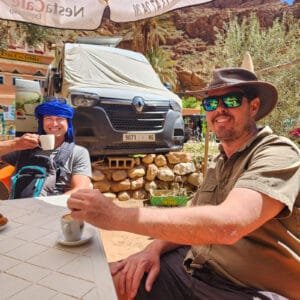
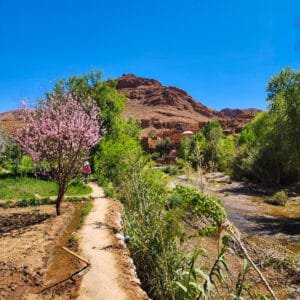
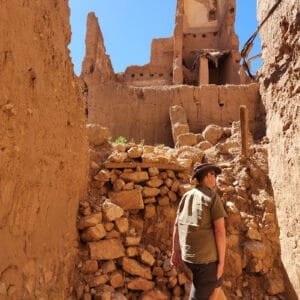
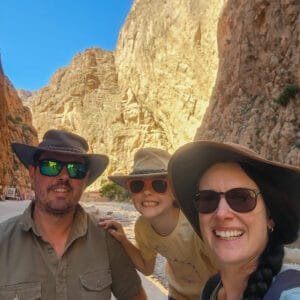
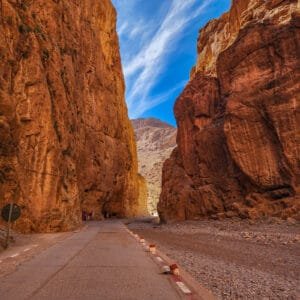
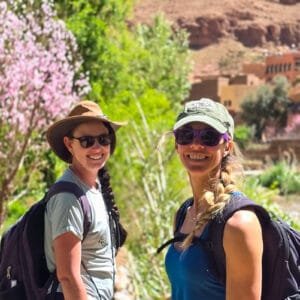
Dades Gorge to Todgha Gorge Loop Drive
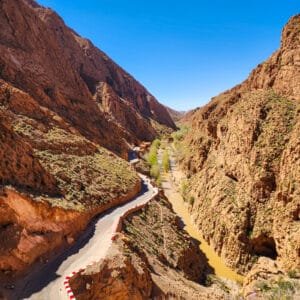

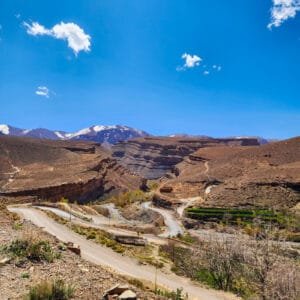
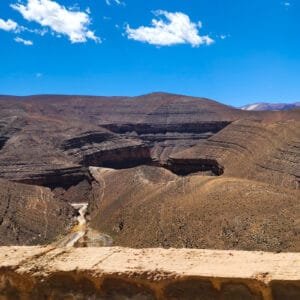
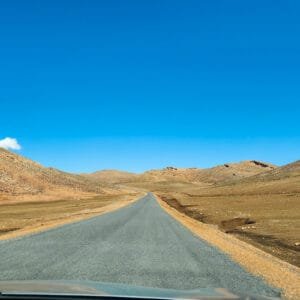


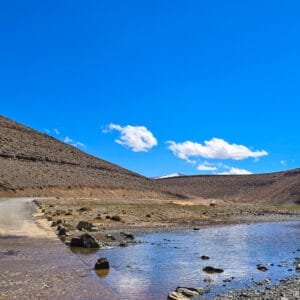
Merzouga & The Sahara Desert (2 Nights) – Golden Dunes, Desert Camps & Unforgettable Moments
The Erg Chebbi dunes near Merzouga are one of Morocco’s most iconic desert landscapes — towering golden waves of sand stretching to the horizon. This part of the Sahara feels like stepping into a dream: camels crossing the ridges at sunset, silence that goes on forever, and skies so clear at night you can see the Milky Way. It’s remote, otherworldly, and something truly special.
This was our favourite experience from our 4 weeks in Morocco, it was truly something special and highly recommend it.
We booked our experience through Merzouga Desert Activities (also the owner of this Riad), left our hire car in the Riad Car Park and climbed onto camels for a 1.5-hour trek into the desert. It was slow and peaceful, the sun casting long shadows across the sand as we rode deeper into Erg Chebbi. Our destination: a traditional Berber camp tucked between the dunes, where we stayed for two nights.
From the camp, we watched the sun rise and set each day, slid down dunes on sandboards and relaxed in the quiet between activities. On day two we rode camels to an Oasis where we were treated with more traditional food and experiences. At night, we sat around the fire under the stars, listening to Berber music and stories, and sharing tagines and mint tea with other travellers. After this we heard the Fennec Fox call so one of the Berber hosts took us to look for it, unfortunately true to its nature, it was unable to be seen, but footprints the following morning were. It was simple, wild, and unforgettable — no roads, no phone reception, just desert life.
If a Berber camp stay doesn’t suit your travel style or group (especially with very young kids or mobility needs), staying in a guesthouse on the edge of the dunes is a great alternative. Towns like Merzouga and Hassi Labied offer plenty of accommodation with the same views and access to camel rides, 4WD dune bashing, and sunset walks — all without the commitment of sleeping out in the sand. We do highly recommend the experience of the camp though, they are very accommodating!

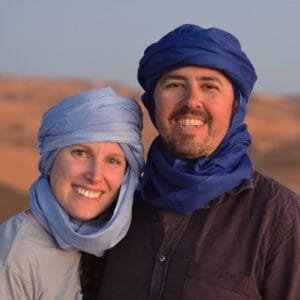
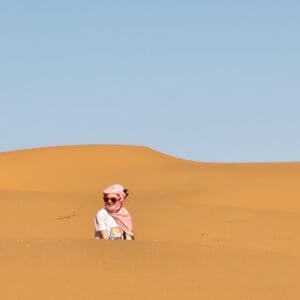
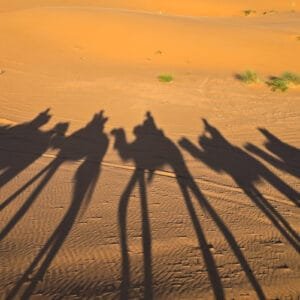
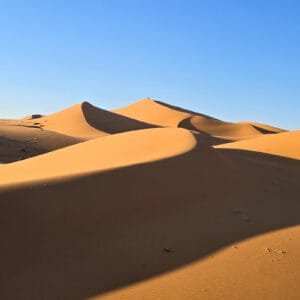
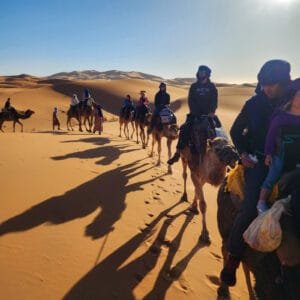
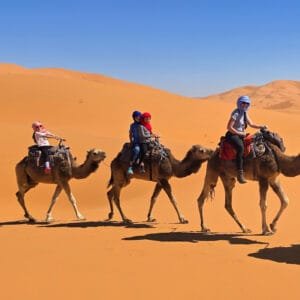
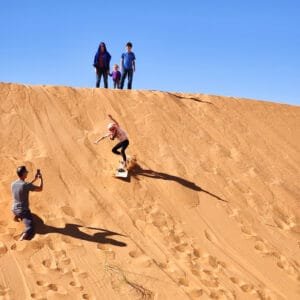
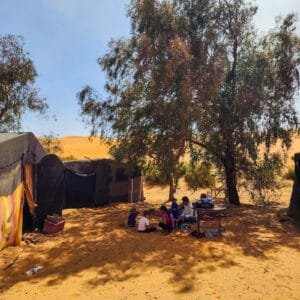
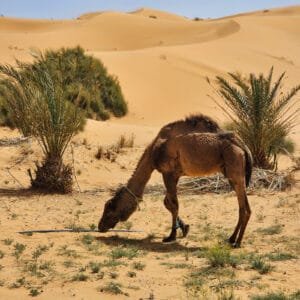

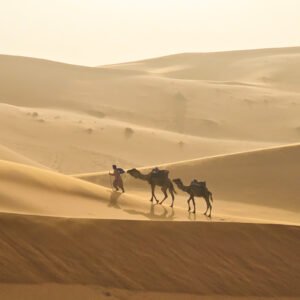
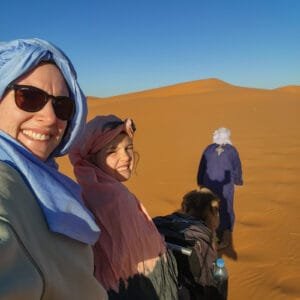
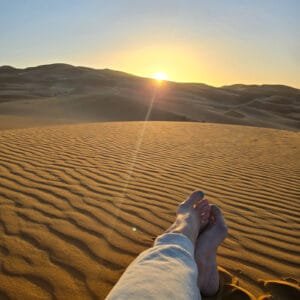
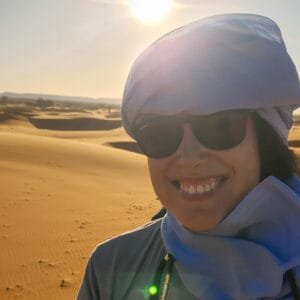
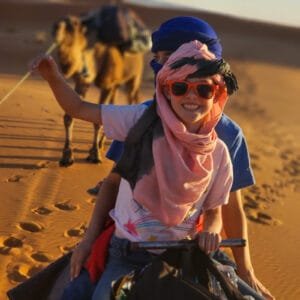

Our Sahara Desert Camp
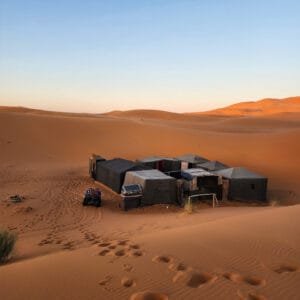
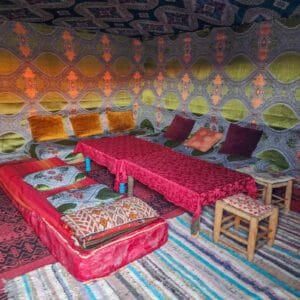
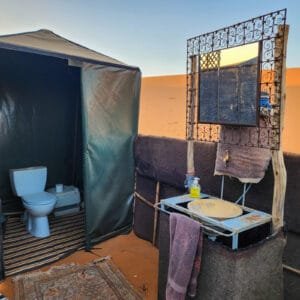
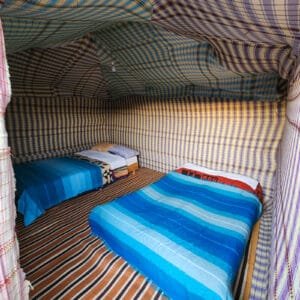
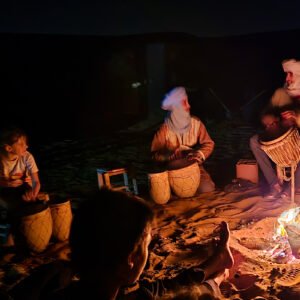
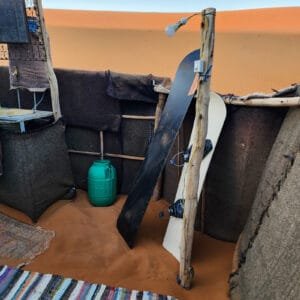

Midelt (1 Night) – A Scenic Stop Between Desert & Mountains
Midelt is a quiet mountain town often used as a stopover between the desert and the northern cities — but it’s also known as the apple capital of Morocco. Surrounded by the Middle Atlas Mountains and fertile valleys, the area’s cooler climate makes it perfect for orchards, especially apples, which you’ll find sold fresh at roadside stalls and local markets.
Things to Do:
- Scenic Drive from Merzouga: The journey from the Sahara north to Midelt is surprisingly varied and beautiful. Make time to stop at the Ziz Canyon lookout for panoramic views of a dramatic valley carved through the rock — a great photo spot. Along the way, you’ll also pass one of Morocco’s largest inland lakes Barrage Al Hassan Addakhil, a rare sight in this arid region and a reminder of the country’s natural diversity.
- Evening Market Stroll: Once in Midelt, take a walk through the local streets and market area. While the town isn’t a major tourist destination, it offers a glimpse of everyday Moroccan life. Locals are friendly, and you’ll likely find fresh produce stalls, bakeries, and the occasional street vendor.
Accommodation:
- Airbnb or Guesthouse Stay: Midelt is a good place to recharge after time in the desert. There are several small hotels and Airbnbs offering reliable hot showers and comfortable beds — worth it after roughing it in the Sahara. While basic, these stays often come with warm hospitality and scenic views of the surrounding mountains.
Where to Eat:
- Local Restaurants in Town: Dining options are limited but welcoming. Look for smaller restaurants near the town centre where service tends to be personal and meals home-style. Prices may be a little higher than in more tourist-heavy areas, but the quality and warmth of the experience often make up for it.
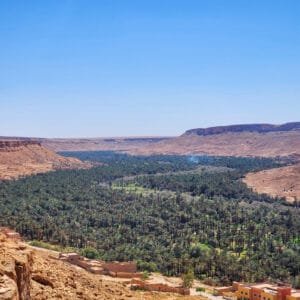
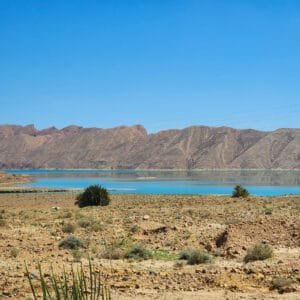
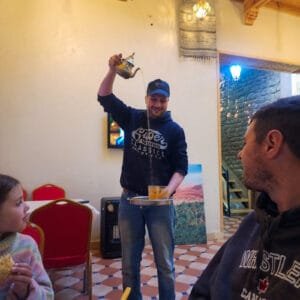
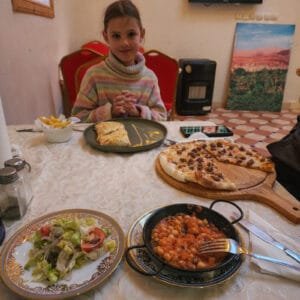
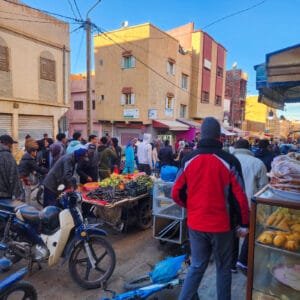
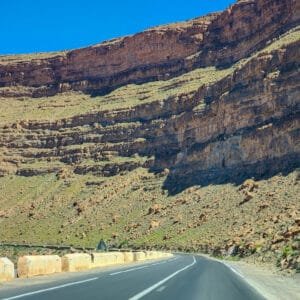
Meknes (2 Nights) – Imperial Grandeur, Local Energy & a Cozy Riad Retreat
Meknes is one of Morocco’s four imperial cities, known for its grand gates, royal history, and more local, lived-in medina experience. Built by Sultan Moulay Ismail in the 17th century as his imperial capital, the city still showcases his legacy through massive fortified walls, ornamental gates, and a blend of Andalusian and Moorish architecture. While not as tourist-heavy Meknes offers a more authentic window into Moroccan life — full of charm, history, and unexpected character.
Things to Do:
- Cedar Forest Stop (En Route): On the way to Meknes, we made a short stop at the Cedar Forest in the Middle Atlas Mountains — a misty, atmospheric place with wild monkeys (which we saw from the car). It’s possible to buy food from locals to feed them, though we personally avoid encouraging wildlife feeding.
- Al Hadeem Square & Medina: This is the beating heart of Meknes and an experience in itself. We saw everything from street performers to an ostrich casually strolling the square. The medina felt genuinely local — vibrant, hectic, and raw.
- Bab El Anaouar & Bab El-Khemis: Meknes is famous for its elaborate city gates. Even under restoration, Bab El Anaouar impressed with its scale and detail, while Bab El-Khemis became a familiar favourite as we passed through it daily from our riad.
- Mausoleum of Moulay Ismail: One of the few religious sites in Morocco that non-Muslims can enter, the mausoleum is serene and beautifully decorated. Moulay Ismail ruled for 55 years and left an indelible mark on the city.
- Volubilis (Optional Side Trip): Just a short drive north, the Roman ruins of Volubilis are a UNESCO World Heritage Site. Due to rain and recent travels in Italy, we opted to view them from the outside — but they’re well worth a visit in better weather.
Accommodation:
- We stayed in an incredible riad just outside Bab El-Khemis, Riad Mogador. From the moment we arrived, we were welcomed like family and blown away by the intricate decor: detailed tilework, carved wood, traditional textiles, and a peaceful central courtyard. The breakfast was generous, with fresh juice, tea, coffee, hot chocolate and more. While gluten-free options were limited, they kindly provided milk so I could enjoy my travel stash of GF cornflakes. A perfect spot to unwind after long travel days and an ideal base for exploring the city.
Where to Eat:
- We followed a recommendation from our riad host and discovered a lovely little restaurant tucked deep within the medina. It was the perfect spot for a quiet lunch away from the bustle, though a bit tricky to find — a reminder to always ask your host for local tips! Meknes isn’t overflowing with tourist-friendly dining, but there are gems hidden in plain sight.




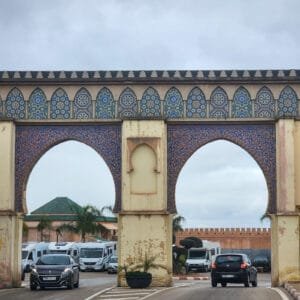
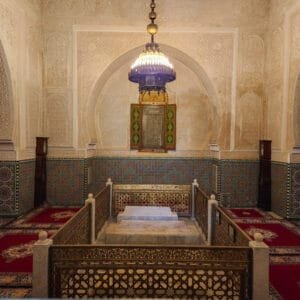

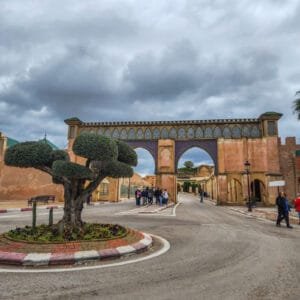
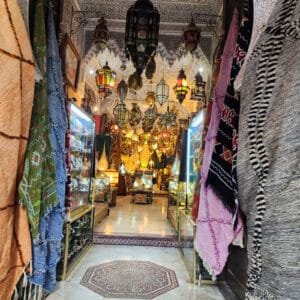

Accommodation
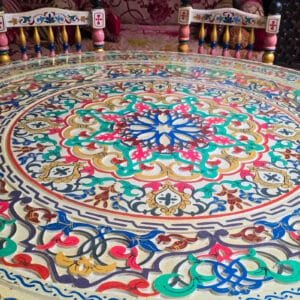
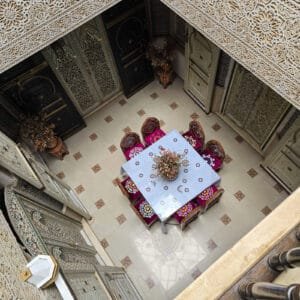



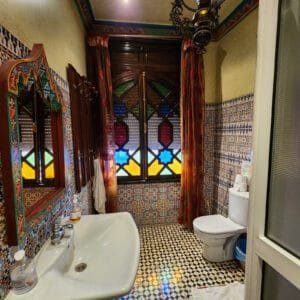
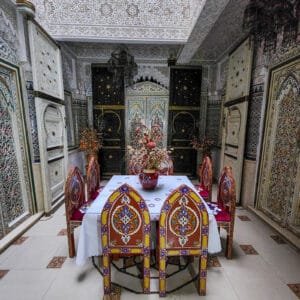
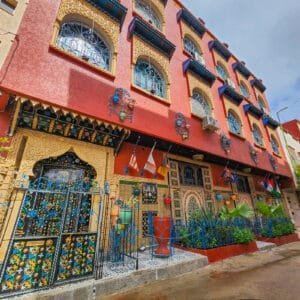
Cedar Forest Monkeys
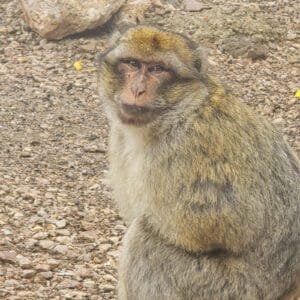
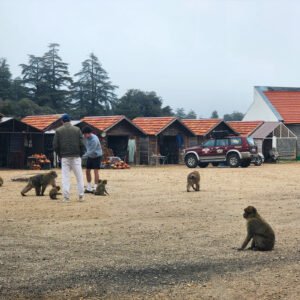

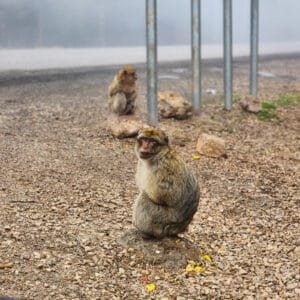
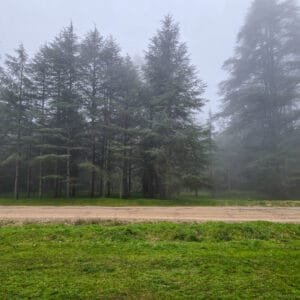
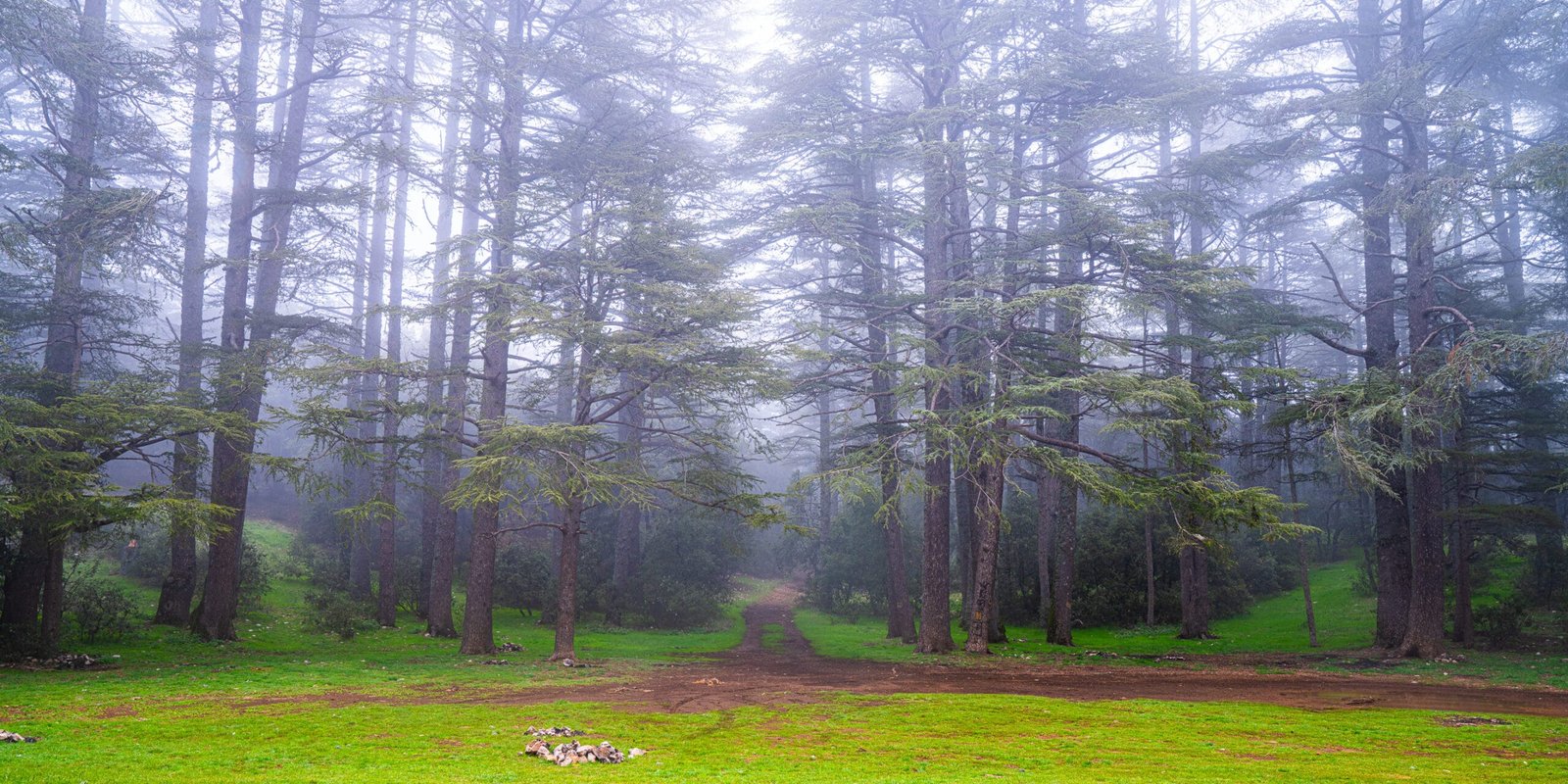
Chefchaouen (3 Nights) – Morocco’s Blue Gem in the Rif Mountains
Tucked away in the northern hills of Morocco, Chefchaouen is a place that seems almost too picturesque to be real. Known as the “Blue Pearl,” this enchanting town is a dreamscape of painted alleyways, mountain views, and gentle rhythms of daily life. After weeks in desert landscapes, the lush green hills leading us here were a surprise on their own — and once we arrived, Chefchaouen’s charm took over instantly. From vibrant textiles to the soft echoes of the call to prayer at sunset, our time here slowed down in the best way.
Things to Do:
- Wander the Blue Medina – The biggest joy in Chefchaouen is simply getting lost in the winding, blue-washed lanes. We walked without a map and without an agenda, soaking in the colour, patterns, cats, mountain views, and the rhythm of local life. It’s a photographer’s dream — every corner reveals another impossibly pretty scene.
- Shop Local Crafts – We couldn’t resist picking up a few handmade pieces here. Chefchaouen is known for its high-quality woven goods — blankets, scarves, and rugs are all beautifully made, and you’ll find a gentler style of bargaining than in larger cities. It was the perfect place to buy some meaningful souvenirs without feeling rushed or pressured.
- Day Trip to Akchour Waterfalls – A highlight of our stay was a day trip to Akchour, about 45 minutes away. The drive is stunning, winding through forested hills and villages. Once there, we did the shorter walk to the Petite Cascade — a pretty spot with water trickling over mossy rocks into a natural pool. It’s a popular local hangout on weekends, so aim for a weekday visit if you prefer a quieter vibe.
- Targha & the Mediterranean Coast – We also took a drive to the tiny seaside town of Targha — a raw and undeveloped stretch of Morocco’s Mediterranean coastline. There’s not much tourism here, but the journey itself was beautiful and peaceful, especially with the mist rolling in from the sea. It made for a unique contrast to the mountain atmosphere of Chefchaouen.
Accommodation:
We based ourselves at Hotel Chefchaouen right in the Medina. It was the perfect location for Chefchaouen, had parking available nearby and highly recommend— we had a rooftop terrace overlooking the town, which was fantastic at sunset. There wasn’t any kitchen or laundry facilities, but we still managed OK. The staff were very welcoming and attentive, and the local cats were super cute.
Where to Eat:
There are countless small eateries in the medina, many with rooftop terraces and welcoming staff. We kept things simple and local — tajines and grilled meats were our go-to dishes. One spot we really enjoyed was tucked down a small alley with only a few tables. It had hearty food, mint tea, and friendly family vibes. The other was right on the main square, with welcoming hosts and was excellent value for money, but the best of all, the views across the medina rooftops at sunset.
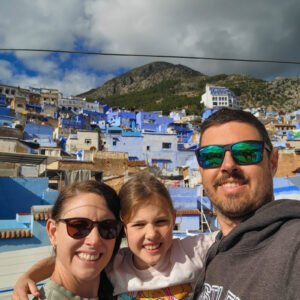
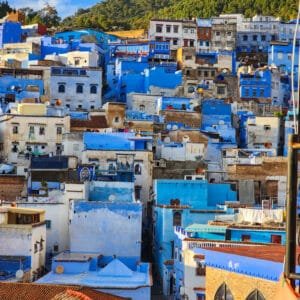
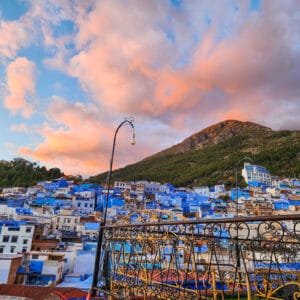
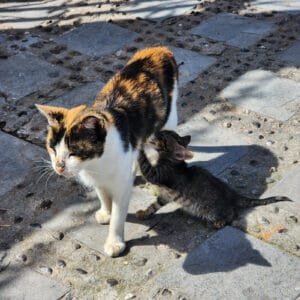
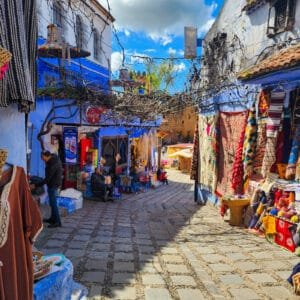
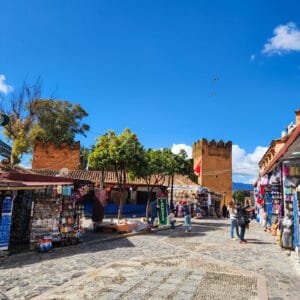

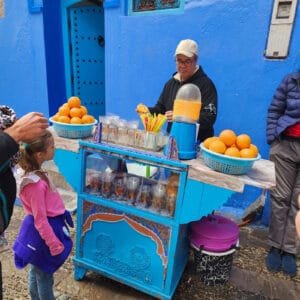
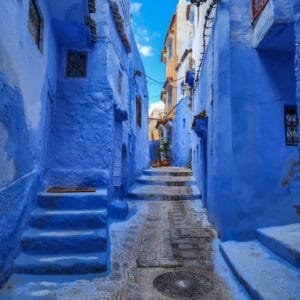
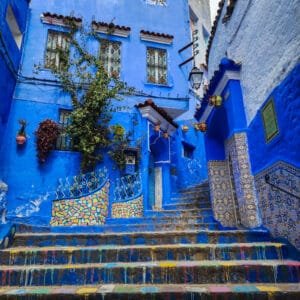



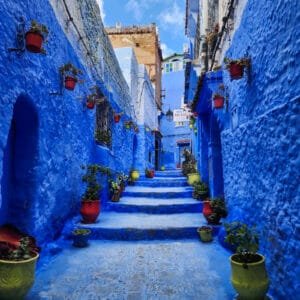

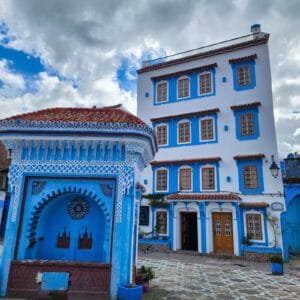
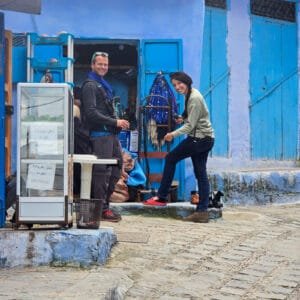


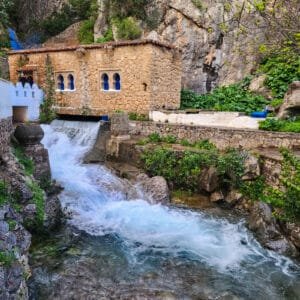
Akchour Waterfalls
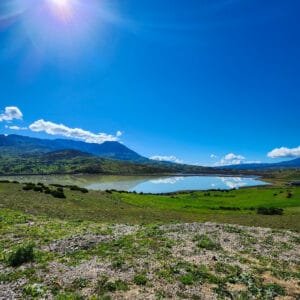
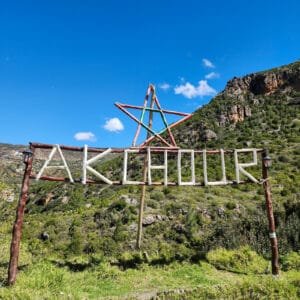
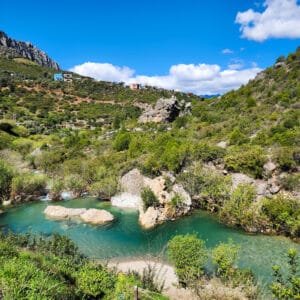
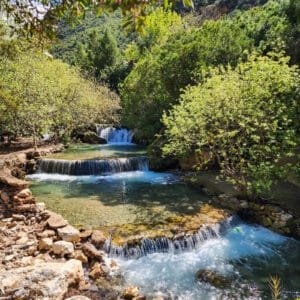
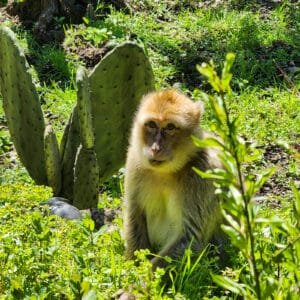

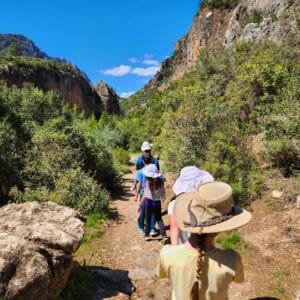
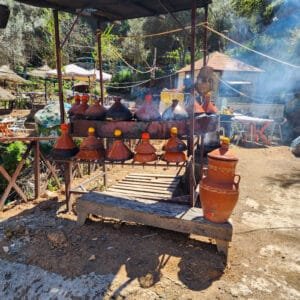
Targha and Med Coast
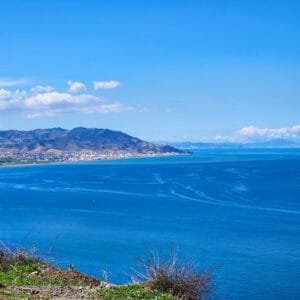
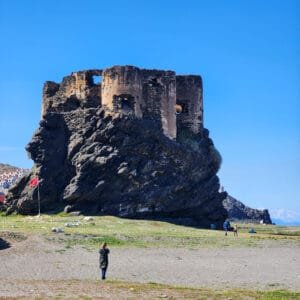



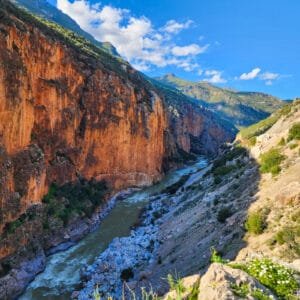
Fes (3 Nights) – Labyrinthine Medinas, Leather Tanneries & Cultural Treasures
Fes is a city that pulls you in and doesn’t let go. It’s Morocco’s oldest imperial city, a cultural and spiritual hub, and the kind of place that feels like it’s barely changed in a thousand years. Founded in the 8th century, its ancient medina is a UNESCO World Heritage Site and home to over 9,000 maze-like alleyways — the largest car-free urban zone in the world. It’s chaotic, overwhelming, and endlessly fascinating.
We definitely got lost, more than once, but it’s part of the experience — surrendering to the noise, the colour, the history unfolding around every corner. But be aware of people trying to ‘help’ you out if you look / are lost – they don’t always have the best intentions!
Things to Do:
- Visit the Chouara Tannery – A visit to Fes isn’t complete without witnessing the age-old process of leather tanning. We climbed up to one of the rooftops overlooking the Chouara Tannery, where workers still process animal hides in vats of natural ingredients like lime, cow urine, salt, and pigeon droppings. The smell is intense (they hand you mint sprigs to help!) but the scene is unforgettable — rows of circular dye pits in rich reds, yellows, and browns, and workers using ancient techniques that date back over 1,000 years.
- Wander the Medina (and get lost) – The medina is the heartbeat of Fes — alive with donkeys hauling goods, craftsmen shaping metal or carving wood, and shopkeepers calling out from stalls overflowing with everything from camel heads to intricate mosaics. You won’t find many signs or street names, so it’s best to embrace the confusion and let your curiosity lead the way. We stumbled upon tiny teahouses, quiet courtyards, and a few memorable surprises.
- Bou Inania Madrasa – This 14th-century madrasa is one of the few religious sites in Morocco open to non-Muslims. It’s incredibly detailed, with carved cedar wood, zellige tiles, and a peaceful inner courtyard. A peaceful pocket in the chaos. There is a small entrance fee to visit which is paid by cash at the time.
- The Water Clock – On one of our wanders, we passed the mysterious Dar al-Magana water clock, which still puzzles historians today. Built in the 14th century,it once measured time using a system of weights and water — but exactly how it functioned remains unsolved.
- The Blue Gate (Bab Boujloud) – Fes’ most recognisable entrance, the Blue Gate, welcomes you into the heart of the medina. From one side, it’s blue (symbolising Fes), and green on the other (symbolising Islam). It’s a good meeting point, photo stop, and orientation marker in a maze of streets.
- Rainbow Street – Hidden deep inside the medina, Rainbow Street adds a burst of modern colour to the ancient tones. A fun little side stop that kids especially enjoyed spotting.
- Try Sand Coffee – Dan gave sand-brewed coffee a go — the beans are roasted and brewed in hot sand right on the street. It’s a strong, gritty experience… let’s just say it was more novelty than new favourite!
Where to Eat:
Fes has some excellent rooftop restaurants where you can escape the busy streets and enjoy a meal with a view. We tucked into grilled chicken, rice, Moroccan Tacos and chicken tagine at one such spot overlooking the medina rooftops.
For street eats, we tried bakery products, breads, and fresh fruits and juices from stalls as we explored. You’ll see plenty of locals eating this way, and while it’s not fancy, it’s flavourful and fast. And if you’re adventurous, you might even spot a camel burger on offer.
Accommodation:
We stayed in a renovated apartment just outside the medina walls. These restored homes are built usually around peaceful courtyards, often with tiled walls, ornate ceilings, and rooftop views of the city. Despite the chaos outside, inside was calm and cool — perfect for catching our breath after navigating the narrow streets. We had really comfortable beds, amazing showers and a well equipped Kitchen (ont that we cooked). The owner was extremely helpful and could also help organise guides, which can be useful for navigating the old city and learning a bit more about its layers of history and culture, if you’re not confident yourself.
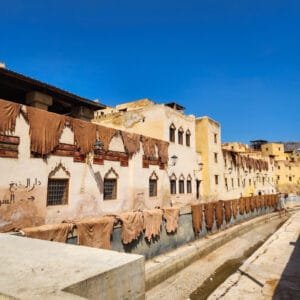
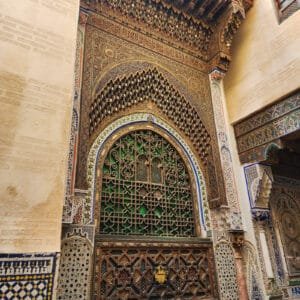

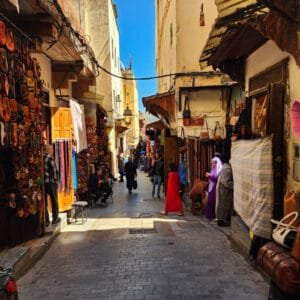
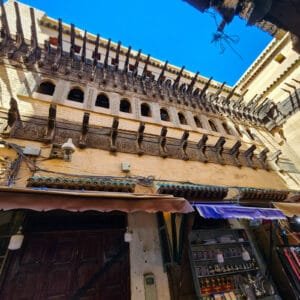
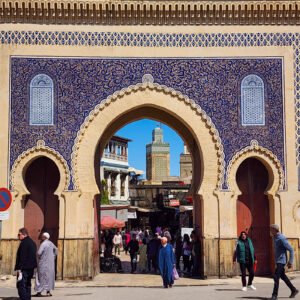
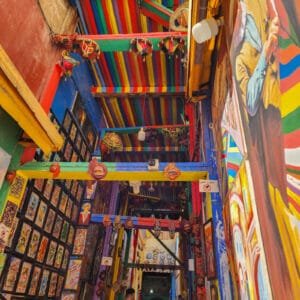
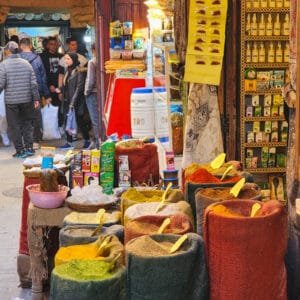
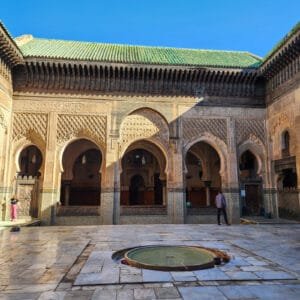
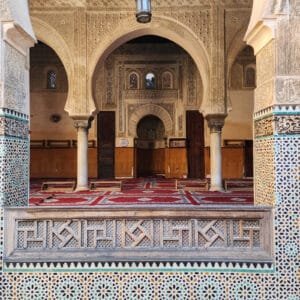
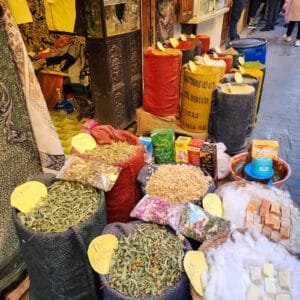
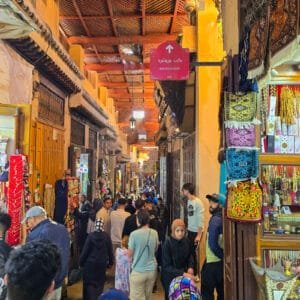
Accommodation



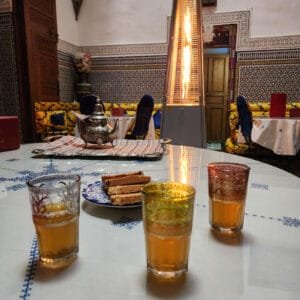
Eating Out

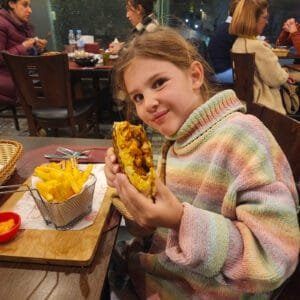
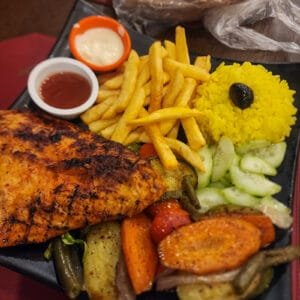
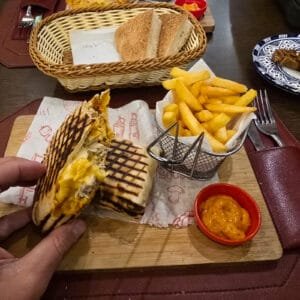
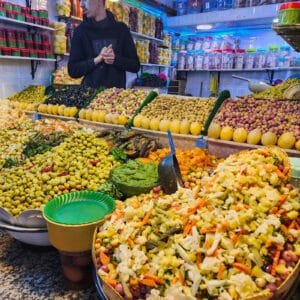
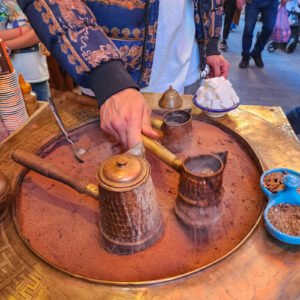
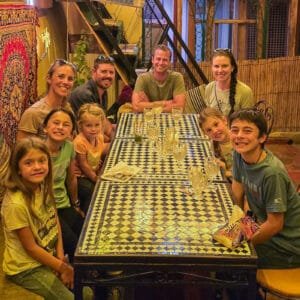
Rabat (2 Nights) – Capital Calm, Coastal Views & A Taste of Modern Morocco
After the bustle of Fes and the chaos of the medinas, Rabat felt like a breath of fresh air. Morocco’s capital city has a calmer, more orderly vibe, with wide roads, working infrastructure, and even a modern tram system. While it might not feature high on every tourist itinerary, it gave us a glimpse into a more lived-in Morocco — where daily life moves at a gentler pace.
Founded in the 12th century and later named capital during the French protectorate in 1912, Rabat blends history, politics, and coastal charm. It’s clean, coastal, and walkable — and while two nights gave us time to rest, 24 hours is enough to see the highlights.
Things to Do:
- Kasbah of the Udayas – A must-visit. This 12th-century fortress perched above the ocean once defended against pirates. Inside, you’ll find narrow blue-and-white lanes, peaceful gardens, and incredible sea views. It felt more Andalusian than Moroccan and was a welcome escape from the usual crowds.
- Coastal Walk – Stroll along the cliffs near the lighthouse and cliffside cemetery — a dramatic coastline and a chance to breathe in fresh sea air. Perfect for stretching legs and letting kids run free.
- The Medina & Main Street – Though not as chaotic as Fes or Marrakech, Rabat’s medina still offers authentic local shops, street snacks, and friendly encounters. The newer main street has cafés, bakeries, and parks that make wandering easy and pleasant.
- Andalusian Gardens Tucked near the Kasbah, these lush, well-maintained gardens are ideal for a picnic or break in the shade. Especially welcome if you’re travelling with little ones needing a quiet moment.
- Hassan Tower & Mausoleum of Mohammed V – If you have extra time, visit these iconic landmarks that represent Morocco’s royal history and architectural grandeur.
Where to Eat:
Our dining choices were limited slightly by a bout of food poisoning (thanks to a dodgy beef burger on night one — Dan will never live it down). But once recovered, we enjoyed a great tajine dinner beside the old city walls. The prices were high and the service was lacking, but we wanted somewhere reputable after the previous night’s unfortunate events.
Accommodation:
We booked an apartment near the medina — affordable and central, with space to recover and catch up on rest. It had everything we needed, including reliable hot water, which can’t be taken for granted in Morocco!
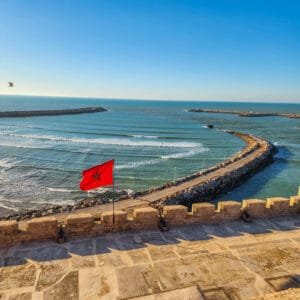
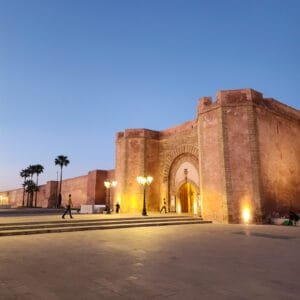
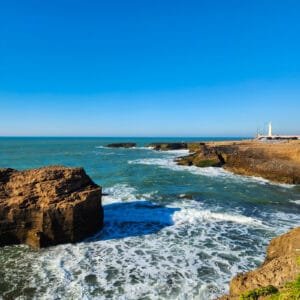

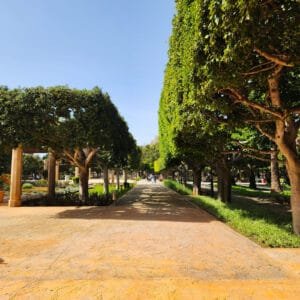
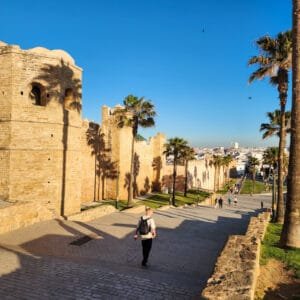
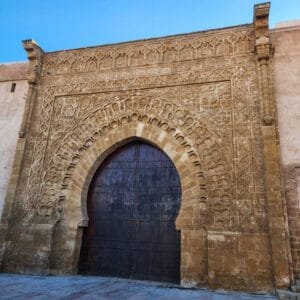
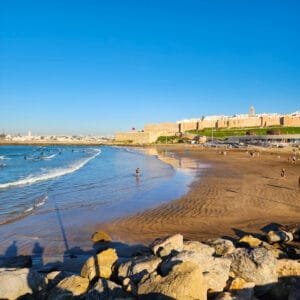
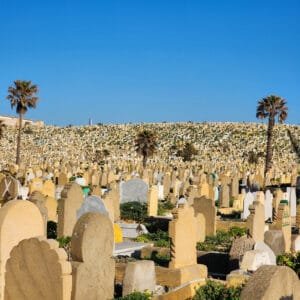
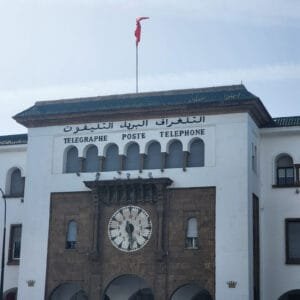
Return to Marrakech (1 Night) – Back to Marrakech Before Flying Out
We returned to Marrakech for our final night purely for logistical reasons — to return the rental car and be close to the airport for our departing flight. We also got to return to the hectic Medina one last time to end Morocco how it started, with a vibe.
It’s always advisable to avoid long-distance travel on the day of a flight. Staying nearby ensures a smoother departure and allows time to handle any unexpected delays without added stress.


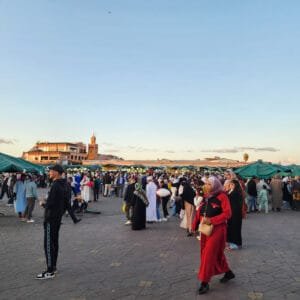
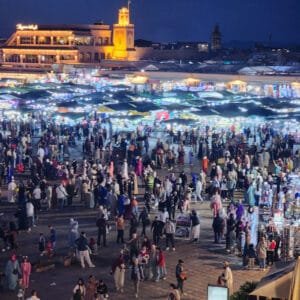
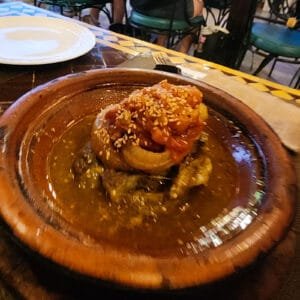
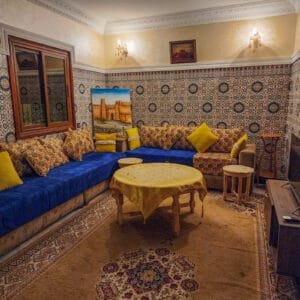
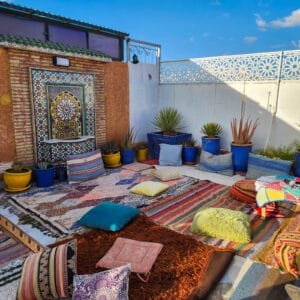

Highlights, Surprises, Tips & Costs
- Favourite Experience: The Sahara Desert campfire night with traditional music. (Other very memorable experiences: Monkey Fingers Hike, Anza dinosaur footprints, driving in the High Atlas Mountains
- Favourite City: Chefchouen
- Most Photogenic: Chefchaouen’s blue alleyways and mountain views.
- Biggest Surprise: How lush and green northern Morocco is!
- Unexpected Challenge: lack of hot water in the showers in some accommodation. Check that in the listing or contact in advance if that is important to you.
Tips:
~ Self drive – it really is the best way to explore Morocco. Just be aware of the crazy drivers and the not-so-honest police.
~ Be aware of scams/pickpockets – these happen in the busy town squares, medinas and tourist attraction areas.
~ Use the post office ATMs to withdraw cash (they’re everywhere and have the best rates)
~ GF food was easy (bread etc available in the supermarkets (usually Carrefour) but fresh produce available everywhere)
~ Don’t drink the tap water, even for brushing teeth
~ Remember to dress culturally appropriate
~ Be prepared for various weather, it does actually rain and don’t just think it will be hot, we even encountered snow
~ Morocco is bigger than you think and quite varied.
~ Toll roads are good and cheap, and less chances of police check points, other roads can be hit and miss with quality, but we didn’t blow a tyre!
~ Toilet paper was hit and miss in accommodation, so carry some with you and tissues don’t really exist, other than in the tiny travel packs
~ Moroccan’s speak lots of languages – English, French, Spanish, Berber, Arabic
~ Phone reception was generally pretty good, some slow internet spots, but had reception almost everywhere we went.
~ Laundromats are not very easy to find. Some accommodation has washing machines, Riads can also offer this service too. We scheduled our washing in and picked accommodation to suit.
~ Places we missed but would recommend – spend more time on the North Coast, High Atlas Mountains surrounding Marrakech and in the central mountains between Fes and Marrakech.
~ Leave off the list if your limited on time: Meknes, Fes, Rabat.
Overall:
We felt safe 95% of the time, just a few instances at night in medinas were a little questionable, it was an incredible adventure that we are glad we did and recommend to you, but it isn’t for the ‘safe’ travellers, you will be out of your comfort zone, even we were a little at times, so if you only go to English speaking countries etc, maybe don’t make Morocco your next trip.
Would we go back?: Yes, but not for some time, it isn’t somewhere we will rush back to. Don’t get me wrong, it was incredible, but we still have so many other places on our wish list!
Costs (in AuD):
Accommodation: $2 434 ($84/night)
Car Hire: $548 ($21/day)
Fuel: $246
Parking, Tolls: $54
Eating Out: $976 ($34/day – usually our dinner meal and snacks each day)
Groceries: $236
Attractions: $9
Travel Insurance: $168
Phone Sims: $75
Flights: $535
Other (Scam, souvenirs, etc): $85
TOTAL: $5441 ($188/day)
If you enjoyed this blog or found it useful, please feel free to click on any of the ads on the page, it doesn’t cost you anything, but it does help us see a little money to cover the hosting costs of the website.
Further, if you are looking to support us in other ways, you can buy a product from our Travel Tools Page, purchase a piece of Dan’s photography art or ‘buy us a coffee“.
We also offer one-on-one travel consultations, via video calls. If you wish for further information, clarification or personalised advice for something specific to your travel needs, feel free to book a session to chat with us.
Finally, don’t forget we have we have heaps of other helpful blogs for both Australia and International Travel on our website.
Disclaimer: I may make a small commission if you buy from our links on our website, it just helps us cover the costs of the website to have this info available for you and costs you nothing more.
Planning a Trip to Morocco?
~ Hiring a car? We recommend getting a quote from DiscoverCars
~ Hiring a Motorhome? We recommend Motorhome Republic
~ Arranged your Travel Insurance? We recommend SafetyWing
~ Booked your accommodation? We use Expedia or Airbnb or TrustedHouseSitters
~ Need a house or Pet Sitter while you’re away? We recommend finding a Trusted House Sitter.
~ Got your E-Sim sorted? We use MobiMatter to stay in touch!
~ Organised your spending money? We use WISE to get the best rate with the lowest fees!
~ Booked your flights? We use SkyScanner to find the best deals!

